spare tire INFINITI QX80 2021 User Guide
[x] Cancel search | Manufacturer: INFINITI, Model Year: 2021, Model line: QX80, Model: INFINITI QX80 2021Pages: 529, PDF Size: 2.05 MB
Page 398 of 529
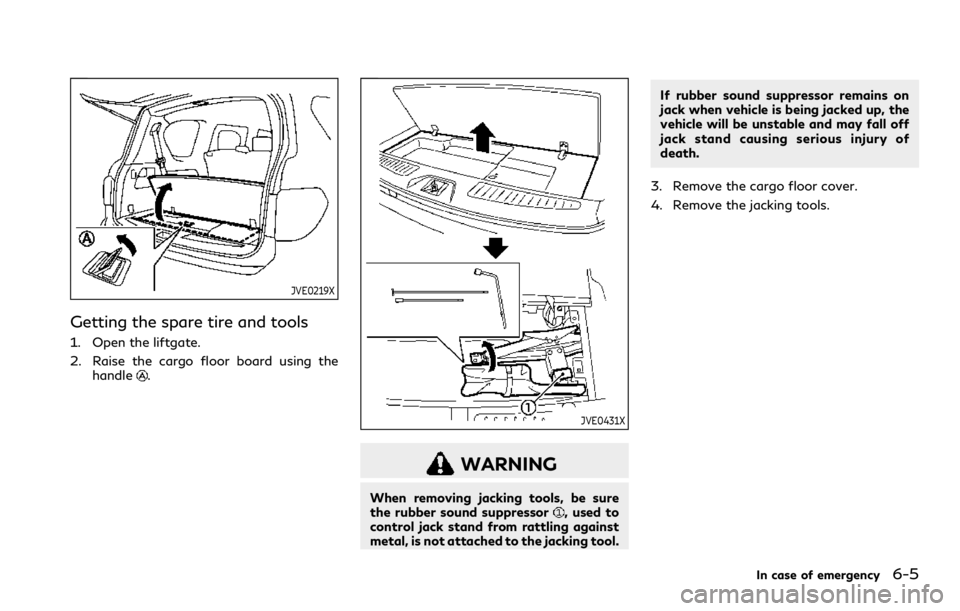
JVE0219X
Getting the spare tire and tools
1. Open the liftgate.
2. Raise the cargo floor board using thehandle
.
JVE0431X
WARNING
When removing jacking tools, be sure
the rubber sound suppressor, used to
control jack stand from rattling against
metal, is not attached to the jacking tool. If rubber sound suppressor remains on
jack when vehicle is being jacked up, the
vehicle will be unstable and may fall off
jack stand causing serious injury of
death.
3. Remove the cargo floor cover.
4. Remove the jacking tools.
In case of emergency6-5
Page 400 of 529
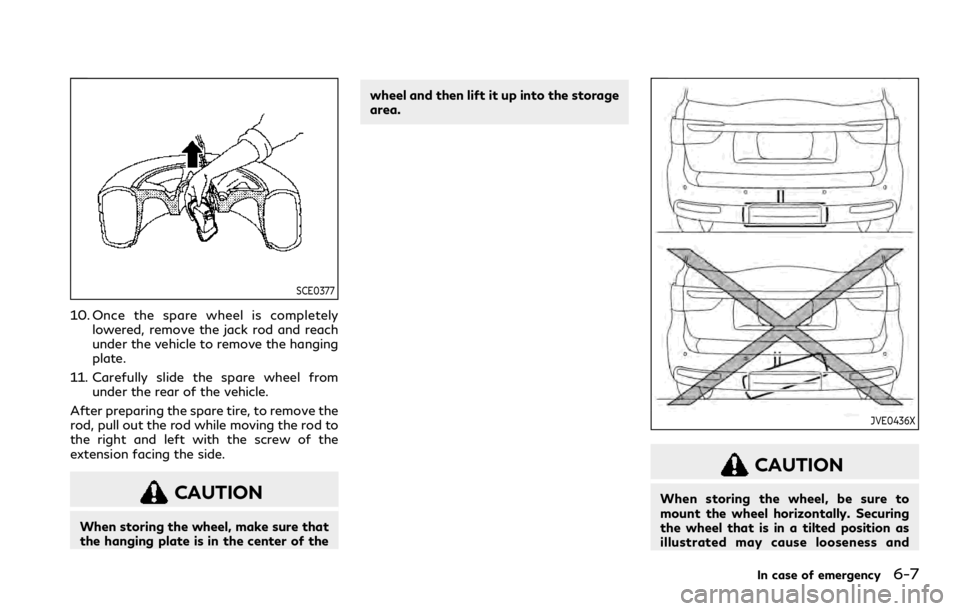
SCE0377
10. Once the spare wheel is completelylowered, remove the jack rod and reach
under the vehicle to remove the hanging
plate.
11. Carefully slide the spare wheel from under the rear of the vehicle.
After preparing the spare tire, to remove the
rod, pull out the rod while moving the rod to
the right and left with the screw of the
extension facing the side.
CAUTION
When storing the wheel, make sure that
the hanging plate is in the center of the wheel and then lift it up into the storage
area.
JVE0436X
CAUTION
When storing the wheel, be sure to
mount the wheel horizontally. Securing
the wheel that is in a tilted position as
illustrated may cause looseness and
In case of emergency6-7
Page 403 of 529
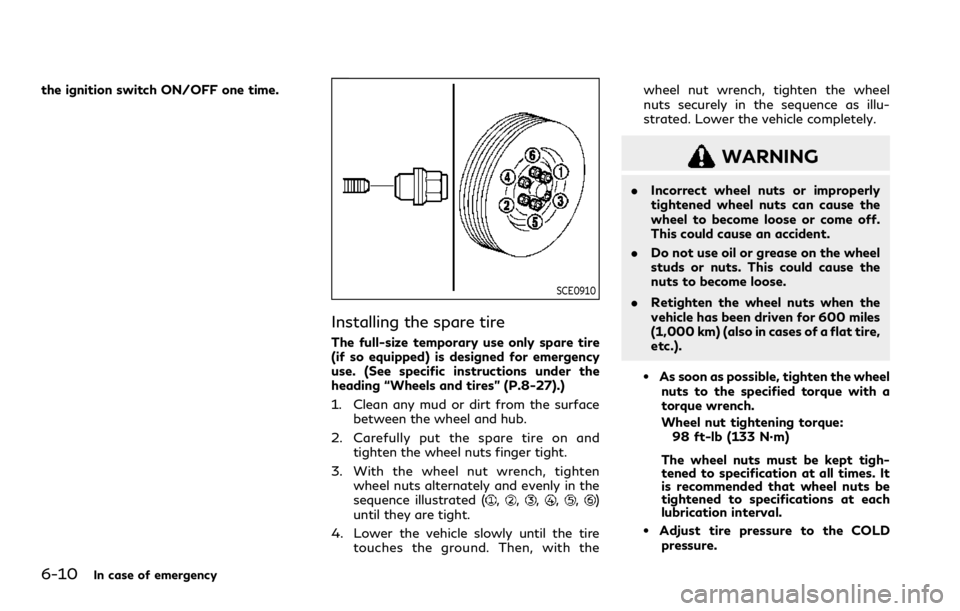
6-10In case of emergency
the ignition switch ON/OFF one time.
SCE0910
Installing the spare tire
The full-size temporary use only spare tire
(if so equipped) is designed for emergency
use. (See specific instructions under the
heading “Wheels and tires” (P.8-27).)
1. Clean any mud or dirt from the surfacebetween the wheel and hub.
2. Carefully put the spare tire on and tighten the wheel nuts finger tight.
3. With the wheel nut wrench, tighten wheel nuts alternately and evenly in the
sequence illustrated (
,,,,,)
until they are tight.
4. Lower the vehicle slowly until the tire touches the ground. Then, with the wheel nut wrench, tighten the wheel
nuts securely in the sequence as illu-
strated. Lower the vehicle completely.
WARNING
.
Incorrect wheel nuts or improperly
tightened wheel nuts can cause the
wheel to become loose or come off.
This could cause an accident.
. Do not use oil or grease on the wheel
studs or nuts. This could cause the
nuts to become loose.
. Retighten the wheel nuts when the
vehicle has been driven for 600 miles
(1,000 km) (also in cases of a flat tire,
etc.).
.As soon as possible, tighten the wheel
nuts to the specified torque with a
torque wrench.
Wheel nut tightening torque: 98 ft-lb (133 N·m)
The wheel nuts must be kept tigh-
tened to specification at all times. It
is recommended that wheel nuts be
tightened to specifications at each
lubrication interval.
.Adjust tire pressure to the COLD pressure.
Page 404 of 529
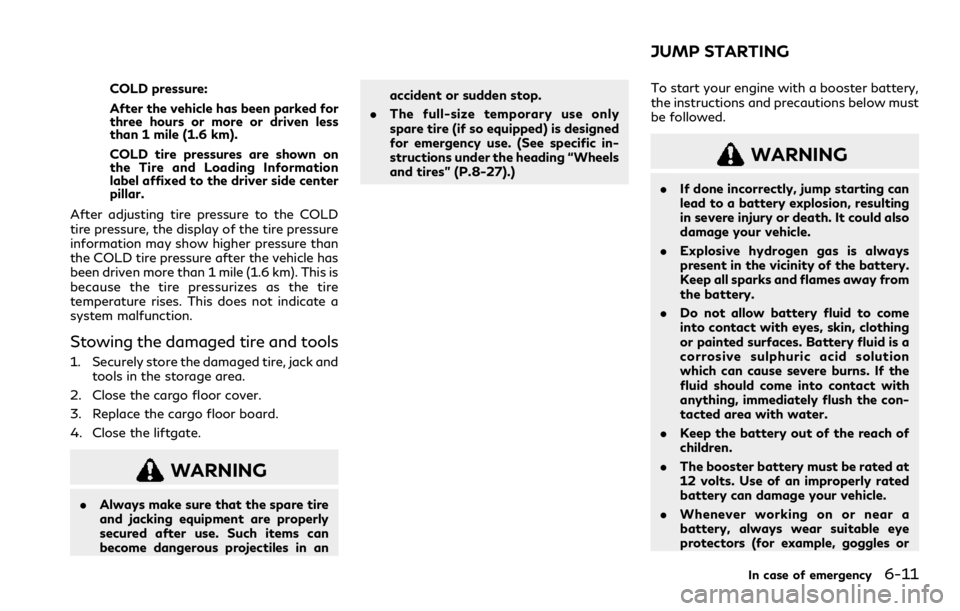
COLD pressure:
After the vehicle has been parked for
three hours or more or driven less
than 1 mile (1.6 km).
COLD tire pressures are shown on
the Tire and Loading Information
label affixed to the driver side center
pillar.
After adjusting tire pressure to the COLD
tire pressure, the display of the tire pressure
information may show higher pressure than
the COLD tire pressure after the vehicle has
been driven more than 1 mile (1.6 km). This is
because the tire pressurizes as the tire
temperature rises. This does not indicate a
system malfunction.
Stowing the damaged tire and tools
1. Securely store the damaged tire, jack and tools in the storage area.
2. Close the cargo floor cover.
3. Replace the cargo floor board.
4. Close the liftgate.
WARNING
. Always make sure that the spare tire
and jacking equipment are properly
secured after use. Such items can
become dangerous projectiles in an accident or sudden stop.
. The full-size temporary use only
spare tire (if so equipped) is designed
for emergency use. (See specific in-
structions under the heading “Wheels
and tires” (P.8-27).) To start your engine with a booster battery,
the instructions and precautions below must
be followed.
WARNING
.
If done incorrectly, jump starting can
lead to a battery explosion, resulting
in severe injury or death. It could also
damage your vehicle.
. Explosive hydrogen gas is always
present in the vicinity of the battery.
Keep all sparks and flames away from
the battery.
. Do not allow battery fluid to come
into contact with eyes, skin, clothing
or painted surfaces. Battery fluid is a
corrosive sulphuric acid solution
which can cause severe burns. If the
fluid should come into contact with
anything, immediately flush the con-
tacted area with water.
. Keep the battery out of the reach of
children.
. The booster battery must be rated at
12 volts. Use of an improperly rated
battery can damage your vehicle.
. Whenever working on or near a
battery, always wear suitable eye
protectors (for example, goggles or
In case of emergency6-11
JUMP STARTING
Page 450 of 529
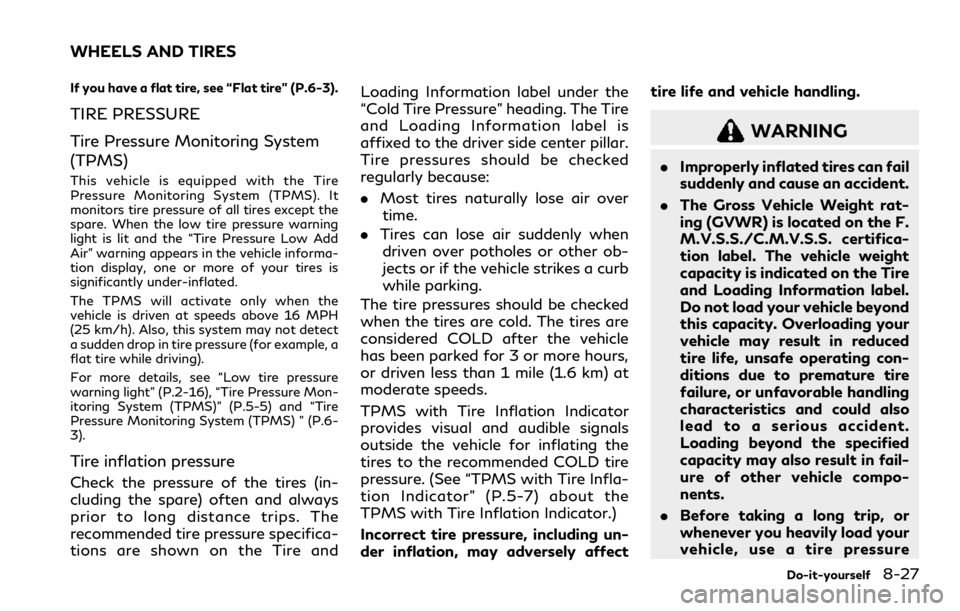
If you have a flat tire, see “Flat tire” (P.6-3).
TIRE PRESSURE
Tire Pressure Monitoring System
(TPMS)
This vehicle is equipped with the Tire
Pressure Monitoring System (TPMS). It
monitors tire pressure of all tires except the
spare. When the low tire pressure warning
light is lit and the “Tire Pressure Low Add
Air” warning appears in the vehicle informa-
tion display, one or more of your tires is
significantly under-inflated.
The TPMS will activate only when the
vehicle is driven at speeds above 16 MPH
(25 km/h). Also, this system may not detect
a sudden drop in tire pressure (for example, a
flat tire while driving).
For more details, see “Low tire pressure
warning light” (P.2-16), “Tire Pressure Mon-
itoring System (TPMS)” (P.5-5) and “Tire
Pressure Monitoring System (TPMS) ” (P.6-
3).
Tire inflation pressure
Check the pressure of the tires (in-
cluding the spare) often and always
prior to long distance trips. The
recommended tire pressure specifica-
tions are shown on the Tire andLoading Information label under the
“Cold Tire Pressure” heading. The Tire
and Loading Information label is
affixed to the driver side center pillar.
Tire pressures should be checked
regularly because:
.
Most tires naturally lose air over
time.
. Tires can lose air suddenly when
driven over potholes or other ob-
jects or if the vehicle strikes a curb
while parking.
The tire pressures should be checked
when the tires are cold. The tires are
considered COLD after the vehicle
has been parked for 3 or more hours,
or driven less than 1 mile (1.6 km) at
moderate speeds.
TPMS with Tire Inflation Indicator
provides visual and audible signals
outside the vehicle for inflating the
tires to the recommended COLD tire
pressure. (See “TPMS with Tire Infla-
tion Indicator” (P.5-7) about the
TPMS with Tire Inflation Indicator.)
Incorrect tire pressure, including un-
der inflation, may adversely affect tire life and vehicle handling.
WARNING
.
Improperly inflated tires can fail
suddenly and cause an accident.
. The Gross Vehicle Weight rat-
ing (GVWR) is located on the F.
M.V.S.S./C.M.V.S.S. certifica-
tion label. The vehicle weight
capacity is indicated on the Tire
and Loading Information label.
Do not load your vehicle beyond
this capacity. Overloading your
vehicle may result in reduced
tire life, unsafe operating con-
ditions due to premature tire
failure, or unfavorable handling
characteristics and could also
lead to a serious accident.
Loading beyond the specified
capacity may also result in fail-
ure of other vehicle compo-
nents.
. Before taking a long trip, or
whenever you heavily load your
vehicle, use a tire pressure
Do-it-yourself8-27
WHEELS AND TIRES
Page 452 of 529

been parked for 3 or more hours,
or driven less than 1 mile (1.6 km)
at moderate speeds. The recom-
mended cold tire inflation is set
by the manufacturer to provide
the best balance of tire wear,
vehicle handling, driveability, tire
noise, etc., up to the vehicle’s
GVWR.
Tire size — see “Tire labeling”
(P.8-31).
Spare tire size or compact spare
tire size (if so equipped)
Do-it-yourself8-29
Page 453 of 529

8-30Do-it-yourself
SDI1949
Checking the tire pressure
1. Remove the valve stem cap fromthe tire.
2. Press the pressure gauge squarely onto the valve stem. Do not press
too hard or force the valve stem
sideways, or air will escape. If the
hissing sound of air escaping from
the tire is heard while checking the
pressure, reposition the gauge to
eliminate this leakage.
3. Remove the gauge. 4. Read the tire pressure on the
gauge stem and compare it to the
specification shown on the Tire
and Loading Information label.
5. Add air to the tire as needed. If too much air is added, press the core of
the valve stem briefly with the tip
of the gauge stem to release
pressure. Recheck the pressure
and add or release air as needed.
6. Install the valve stem cap.
7. Check the pressure of all other tires, including the spare.
8. Check the pressure when driving the vehicle at speeds of 100 mph
(160 km/h) or higher where it is
legal to do so.
WARNING
. Driving at high speeds, 100 mph (160
km/h) or higher sustained where it is
legal to do so, can cause tires to have
excessive heat build up, which may
result in a tire failure causing loss of
control, crash, injuries or even death.
Some high-speed rated tires require inflation pressure adjustment for
high-speed operation. When speed
limits and road conditions allow ve-
hicle driving at high speeds, make
sure tires are rated to support high
speed operation, tires are in optimal
conditions and pressure is adjusted to
correct cold inflation pressure for
high speed operation.
. Tires require adjustment to the infla-
tion pressure when driving the vehicle
at speeds of 100 mph (160 km/h) or
higher where it is legal to do so. See
recommended tire inflation chart for
correct operating pressure.
. After vehicle high speed operation
has ended, readjust the tire pressure
to the recommended cold inflation
pressure. (See “Checking the tire
pressure” (P.8-30).)
Page 454 of 529

SizeCold Tire In-
flation Pres- sure
Front Original Tire:
P275/50R22 111H 35 psi, 240
kPa
Front Original Tire:
P275/60R20 114H 35 psi, 240
kPa
Rear Original Tire:
P275/50R22 111H 35 psi, 240
kPa
Rear Original Tire:
P275/60R20 114H 35 psi, 240
kPa
Spare Tire:
275/60R20 115M 35 psi, 240
kPa
Spare Tire:
265/70R18 116M 51 psi, 350
kPa
Recommended tire inflation pressures at
speeds of 100 mph (160 km/h) or higher
where it is legal to do so.
SizeCold Tire In-
flation Pres- sure
Front Original Tire:
P275/50R22 111H 41 psi, 280
kPa
Front Original Tire:
P275/60R20 114H 36 psi, 250
kPa
Rear Original Tire:
P275/50R22 111H 41 psi, 280
kPa
Rear Original Tire:
P275/60R20 114H 36 psi, 250
kPa
SDI1575
Example
TIRE LABELING
Federal law requires tire manufac-
turers to place standardized informa-
tion on the sidewall of all tires. This
information identifies and describes
the fundamental characteristics of
the tire and also provides the tire
identification number (TIN) for safety
standard certification. The TIN can be
used to identify the tire in case of a
recall.
Do-it-yourself8-31
Page 457 of 529

8-34Do-it-yourself
year, including snowy and icy road condi-
tions. All Season tires are identified by ALL
SEASON and/or M&S (Mud and Snow) on
the tire sidewall. Snow tires have better
snow traction than All Season tires and may
be more appropriate in some areas.
Summer tires
INFINITI specifies summer tires on some
models to provide superior performance on
dry roads. Summer tire performance is
substantially reduced in snow and ice. Sum-
mer tires do not have the tire traction rating
M&S on the tire sidewall.
If you plan to operate your vehicle in snowy
or icy conditions, INFINITI recommends the
use of SNOW tires or ALL SEASON tires on
all four wheels.
Snow tires
If snow tires are needed, it is necessary to
select tires equivalent in size and load rating
to the original equipment tires. If you do not,
it can adversely affect the safety and
handling of your vehicle.
Generally, snow tires will have lower speed
ratings than factory equipped tires and may
not match the potential maximum vehicle
speed. Never exceed the maximum speed
rating of the tire.
If you install snow tires, they must be thesame size, brand, construction and tread
pattern on all four wheels.
For additional traction on icy roads, studded
tires may be used. However, some U.S.
states and Canadian provinces prohibit their
use. Check local, state and provincial laws
before installing studded tires. Skid and
traction capabilities of studded snow tires,
on wet or dry surfaces, may be poorer than
that of non-studded snow tires.
TIRE CHAINS
Use of tire chains may be prohibited accord-
ing to location. Check the local laws before
installing tire chains. When installing tire
chains, make sure they are the proper size
for the tires on your vehicle and are installed
according to the chain manufacturer’s sug-
gestions.
Use only SAE Class S chains. Class
“S” chains are used on vehicles with re-
stricted tire to vehicle clearance. Vehicles
that can use Class “S” chains are designed to
meet the SAE standard minimum clearances
between the tire and the closest vehicle
suspension or body component required to
accommodate the use of a winter traction
device (tire chains or cables). The minimum
clearances are determined using the factory
equipped tire size. Other types may damage
your vehicle. Use chain tensioners when
recommended by the tire chain manufac-
turer to ensure a tight fit. Loose end links of the tire chain must be secured or removed to
prevent the possibility of whipping action
damage to the fenders or underbody. If
possible, avoid fully loading your vehicle
when using tire chains. In addition, drive at
a reduced speed. Otherwise, your vehicle
may be damaged and/or vehicle handling
and performance may be adversely affected.
Tire chains must be installed only on the
rear wheels and not on the front wheels.
Never install tire chains on the full-size
temporary use only spare tire (if so
equipped).
Do not use tire chains on dry roads. Driving
with tire chains in such conditions can cause
damage to the various mechanisms of the
vehicle due to some overstress.
Page 458 of 529

SDI1662
CHANGING WHEELS AND TIRES
Tire rotation
INFINITI recommends rotating the
tires every 7,500 miles (12,000 km).
(See “Flat tire” (P.6-3) for tire repla-
cing procedures.)
As soon as possible, tighten the
wheel nuts to the specified torque
with a torque wrench.Wheel nut tightening torque:98 ft-lb (133 N·m)
The wheel nuts must be kept tigh- tened to the specification at all times.
It is recommended that wheel nuts be
tightened to the specification at each
tire rotation interval.
WARNING
.
After rotating the tires, check
and adjust the tire pressure.
. Retighten the wheel nuts when
the vehicle has been driven for
600 miles (1,000 km) (also in
cases of a flat tire, etc.).
. Do not include the full-size
temporary use only spare tire
(if so equipped) in the tire
rotation.
. For additional information re-
garding tires, refer to “Impor-
tant Tire Safety Information”
(US) or “Tire Safety Informa-
tion” (Canada) in the Warranty
Information Booklet.
SDI1663
1.Wear indicator
2.Wear indicator location mark
Tire wear and damage
WARNING
.Tires should be periodically in-
spected for wear, cracking, bul-
ging or objects caught in the
tread. If excessive wear, cracks,
bulging or deep cuts are found,
the tire(s) should be replaced.
. The original tires have built-in
Do-it-yourself8-35